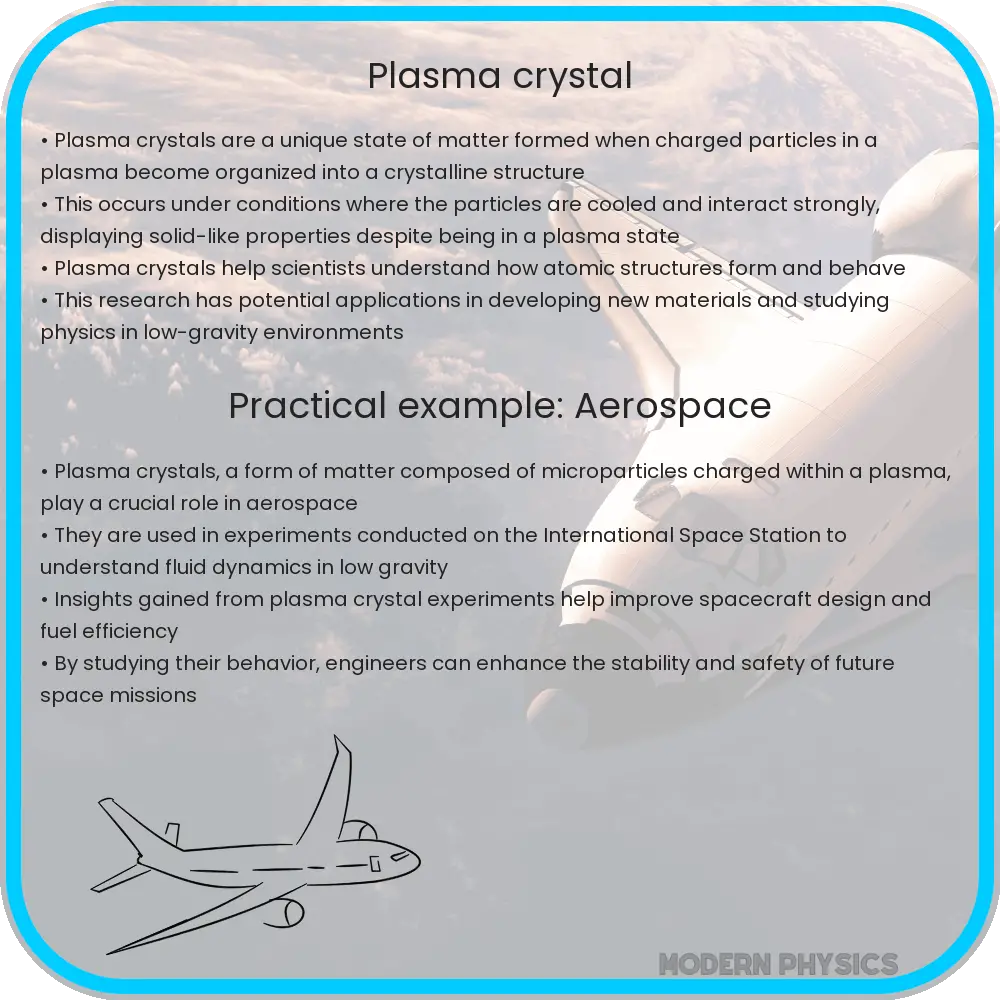Explore the intriguing world of plasma crystals, their forms, applications in technology and research, and their impact on materials science and space exploration.

Introduction to Plasma Crystals
Plasma crystals represent a unique state of soft matter, combining properties of classical crystalline solids with the fluidity and dynamism of plasmas. Discovered in the late 20th century, these structures consist of microparticle suspensions within a plasma, where particles become charged and arrange themselves into a crystalline lattice due to electrostatic forces. This fascinating phase of matter opens up new avenues for research and applications in both fundamental physics and practical engineering.
Forms of Plasma Crystals
Plasma crystals can manifest in various forms, depending on the conditions under which they are created, such as pressure, temperature, and the electric and magnetic fields applied. The most common form is the three-dimensional (3D) crystal structure, observed in laboratory settings. These structures exhibit ordered patterns similar to those found in traditional solid crystals but are formed from charged particles in a gaseous plasma. Additionally, two-dimensional (2D) plasma crystals have been observed, offering simpler systems for studying the fundamental principles of crystalline order and dynamics.
Applications of Plasma Crystals
The unique properties of plasma crystals have paved the way for numerous applications across various fields. In the realm of space exploration, plasma crystals offer insights into astrophysical processes, including the formation of cosmic dust structures. On Earth, they find applications in material science, where the controlled environments of plasma crystals can aid in the synthesis of new materials with tailored properties. Furthermore, their behavior under microgravity conditions, studied aboard the International Space Station (ISS), provides valuable data for understanding fluid dynamics, phase transitions, and the fundamental forces governing particle interactions.
Ongoing Research and Developments
Research into plasma crystals is a vibrant field, with scientists exploring their theoretical foundations, experimental realizations, and potential applications. Current studies focus on understanding the phase transitions between different states of plasma crystals, the kinetic properties of these systems, and how external conditions affect their structure and dynamics. This research not only deepens our understanding of plasma crystals but also contributes to advancements in condensed matter physics, materials science, and various technological applications.
Technological Implications and Future Directions
The study of plasma crystals extends beyond theoretical interest, offering practical implications for technology and engineering. Their unique properties enable the development of advanced materials with specific mechanical, electrical, and optical characteristics. For instance, by manipulating the arrangement and phase of plasma crystals, researchers can engineer materials with desired thermal conductivity or electromagnetic properties. This has potential applications in creating more efficient semiconductors, photonic devices, and sensors.
In addition to materials science, plasma crystal research contributes to the advancement of plasma technology itself, including plasma screens, ion thrusters for spacecraft, and even plasma medicine, where the properties of plasma crystals can inform new treatment methodologies. The interdisciplinary nature of plasma crystal studies also facilitates collaborations across physics, chemistry, materials science, and engineering, promising innovative solutions to complex problems.
Challenges and Opportunities
Despite the promising prospects, the study and application of plasma crystals face several challenges. The creation and maintenance of stable plasma crystal structures require precise control over environmental conditions, which can be difficult and costly. Moreover, translating laboratory-scale experiments to practical applications involves overcoming significant technical hurdles. However, these challenges also present opportunities for innovation in experimental techniques, theoretical models, and computational simulations.
Future research will likely focus on enhancing the stability and scalability of plasma crystals, exploring their quantum mechanical properties, and developing new applications in technology and industry. As computational resources and experimental methods continue to advance, the exploration of plasma crystals will expand, potentially uncovering phenomena that could revolutionize our understanding of matter and its applications.
Conclusion
Plasma crystals, straddling the boundary between classical crystalline structures and fluid plasmas, represent a fascinating frontier in physics and materials science. Their study not only enriches our understanding of fundamental physical processes but also opens up new pathways for technological innovation. As researchers continue to unravel the mysteries of plasma crystals, we can anticipate developments that will impact various domains, from space exploration to nanotechnology. The ongoing exploration of plasma crystals embodies the spirit of scientific inquiry, driving forward our quest for knowledge and its application for the betterment of humanity.
